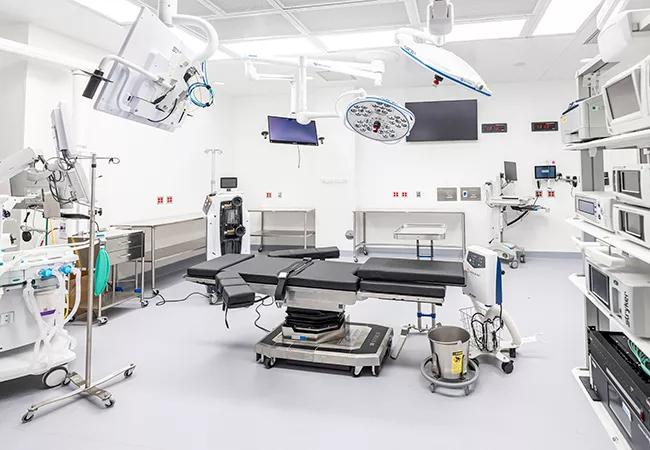Dedicated committee and surgical fellowship strive for sustainability, energy efficiency, waste reduction

From voracious energy consumption to prodigious greenhouse gas (GHG) emissions, waste generation and landfill deposits, healthcare systems worldwide have an outsize impact on the environment, contributing to pollution and climate change.
Advertisement
Cleveland Clinic is a non-profit academic medical center. Advertising on our site helps support our mission. We do not endorse non-Cleveland Clinic products or services. Policy
And operating rooms (ORs) are ground zero for the healthcare sector’s adverse environmental effects.
Despite their proportionally small size, ORs use as much as 6% more energy per square foot than all other hospital departments, driven by ventilation, lighting and electronic equipment demands throughout much of the day. They produce more than 30% of a hospital’s total waste and two-thirds of its regulated medical waste. OR anesthetic gases contribute to the hospital’s GHG burden. And OR sterility requirements result in the disposal of huge volumes of single-use items.
Recognizing the imperative for change, Cleveland Clinic began more than a decade ago to reduce the environmental impact of the more than 210 ORs across its health system as part of the organization’s longstanding overall sustainability program.
“What we do in our hospitals is meant to improve our communities, but our buildings, the materials we use and how we practice can negatively affect people’s health,” says general surgeon Sofya Asfaw, MD, MBA, who helped found and currently serves on Cleveland Clinic’s Greening the OR Committee. “As a surgeon, the fact that our specialty’s collective practices in the OR contribute to this problem was jarring to me. Cleveland Clinic’s mandate is to be a good environmental steward. We decided to be leaders for change.”
The resulting Greening the OR initiative has achieved notable improvements in energy and resource conservation, GHG emissions, waste output and recycling, while also decreasing costs. The program — along with a unique fellowship that trains surgical residents in healthcare sustainability — serves as a guide for other healthcare systems and has prompted vendors and suppliers to increase their own sustainability efforts.
Advertisement
Cleveland Clinic’s OR greening and sustainability efforts have earned national recognition. For eight consecutive years, the healthcare system has received the Top 25 Environmental Excellence award from Practice Greenhealth, a national sustainable healthcare organization.
“Healthcare has woken up to the possibility of sustainability in the last couple of years,” says Jon Utech, Cleveland Clinic’s Senior Director, Sustainability. “The Greening the OR program and the fellowship were way ahead of their time. In terms of reducing energy usage and reusing supplies, the program was one of the earliest and biggest success stories. The good news is that a lot of other healthcare systems see what we’re doing and are asking how they can implement it themselves. That’s the ultimate victory, because that’s how we impact global health.”
Cleveland Clinic’s efforts to comprehensively address environmental and sustainability issues began with the creation of a Sustainability Team in 2007 and the institution’s commitment in 2008 to join the United Nations Global Compact, a worldwide pact among organizations to adopt sustainability and social responsibility policies.
The Sustainability Team sets the strategic direction for Cleveland Clinic’s environmental stewardship, provides operational support and promotes caregiver engagement in sustainability. The Sustainability Team’s activities include overseeing green building practices; ensuring environmentally responsible operating processes and purchasing; educating caregivers; and building partnerships to improve the sustainability of Cleveland Clinic’s home communities.
Advertisement
In 2013, the Sustainability Team convened an enterprise-wide multidisciplinary Greening the OR Committee to collaboratively and cost-effectively reduce OR resource use and improve sustainability. Cleveland Clinic’s interest in the concept had been sparked by a Practice Greenhealth pilot project to demonstrate the OR’s role in environmental strategies.
At the time of the Greening the OR Committee’s inception, Dr. Asfaw was serving as Cleveland Clinic’s inaugural Kenneth Lee Memorial Fellow. This novel fellowship for surgical residents — named for the late Cleveland Clinic general surgeon Kenneth Lee, MD, a gifted teacher who advocated for OR waste reduction — targets healthcare sustainability, particularly in the OR, and enables fellows to execute a defined project to drive change locally and nationally.
“Dr. Lee was an excellent teacher in the operating room. He always noted wasteful practices and asked how we could improve,” Dr. Asfaw says. “The fellowship is his legacy and I had the distinct pleasure of being invited to be the first fellow. I felt a lot of hope about the impact and changes we could make.”
Dr. Asfaw became a founding member of the Greening the OR Committee. The body includes members of Cleveland Clinic’s professional staff of physicians and researchers as well as representatives from facilities, buildings and properties, surgical operations, nursing, clinical engineering, anesthesia and supply chain.
A Greening the Labs Committee started by pathologist Ilyssa Gordon, MD, PhD, Medical Director of Sustainability in Cleveland Clinic’s Robert J. Tomsich Pathology & Laboratory Medicine Institute, to improve the environmental status of the organization’s research labs, has merged with the Greening the OR committee. The combination enables a unified effort across surgical and research operations. Dr. Gordon developed an online course to educate pathology and laboratory staff about recycling and has integrated sustainability education into the pathology residency program.
Advertisement
The Greening the OR Committee brings together key decision-makers and influencers to identify and vet new sustainability opportunities. It also leads initiatives to engage caregivers in OR and lab sustainability and works to embed sustainability requirements into revised OR and lab construction standards.
The committee’s cross-functional makeup has been essential to the movement’s success. “Every discipline needs to be a part of this so we can work together,” Dr. Asfaw says. “You must have support and buy-in from your leaders, but it also comes from the grassroots. Attacking this issue multidirectionally is important.”
One constituency, however, could make or break the OR greening initiative. Surgeons control operating room practices, acting based on perceived best practices, training and habit. Adopting new, more sustainable approaches required gaining their acceptance.
“As surgeons, we generally like it our way,” Dr. Asfaw acknowledges. “It can be hard to change. One of the things that’s really important is showing people data — showing our surgeons and other healthcare providers the evidence base behind these practices and that they’re actually better for our patients. That has worked very well. Even those who might have been skeptical 10, 12 years ago when we were starting are now huge advocates.”
There’s also a ripple effect, Utech adds. “Having surgeons and physicians leading the OR greening work inspires people in other parts of the healthcare system to take action as well,” he says.
Advertisement
The Greening the OR program targets — and has made considerable progress in — two key areas: energy efficiency and waste reduction/recycling.
Most of ORs’ energy consumption is due to heating, ventilation and air conditioning (HVAC) needs, not only to maintain a comfortable environment but to ensure adequate airflow for sterility. Laboratories that perform pre- and postoperative blood and tissue analysis also are energy-intensive because of their HVAC systems, electronic equipment and cold storage. Reducing energy use decreases the need to generate power by burning fossil fuels, which in turn cuts pollution and greenhouse gas emissions.
OR and lab energy efficiency improvements at Cleveland Clinic include:
Cleveland Clinic’s overall energy efficiency improvements — which include significant contributions from OR and lab changes — have saved the health system more than $100 million since 2010, Utech says. “We’ve added more buildings, but by using less energy in each building, we’ve brought our energy costs and carbon footprint down even as we’ve grown as a healthcare system.”
If the voluminous waste generated by hospital ORs and labs ends up in landfills, it contributes to methane emissions, groundwater pollution and the proliferation of microplastics, all of which harm human health and the environment. Regulated medical waste, also known as infectious or biohazardous waste, must be treated to render it sterile before disposal, either through incineration, heating or exposure to chemical agents — again, with negative environmental and health impacts.
Recycling, when possible, is one way to reduce OR-generated waste. Other effective tactics include minimizing the use of unnecessary surgical materials, opting for reusable instead of single-use surgical instruments, employing alternatives to disposable plastic sterilization wrap, and reducing waste anesthesia gases that contribute to global warming.
In addition to taking steps internally to reduce waste, Cleveland Clinic looks for upstream opportunities. A representative of supply chain management serves on the Greening the OR Committee, ensuring a shared approach to responsible purchasing strategies. The healthcare system also chooses suppliers based in part on their commitment to sustainability, willingness to collaborate on waste reduction and ability to provide reusable and recyclable products. Cleveland Clinic’s size and purchasing volume enables it to exert some influence on suppliers’ practices.
“We’ve talked to our top 50 suppliers in the last couple of years,” Utech says. “We’re making it clear why the environmental goals that the Greening the OR program supports need to be important to them, too. It’s now wired into our supply chain management process that we talk about the environmental and social performance.”
In 2021, Cleveland Clinic and 11 other health systems signed the Impact Purchasing Commitment, pledging to direct their purchasing toward companies that provide sustainable products and services .
While improving the environment is paramount, sustainable OR activities also produce economic benefits.
“Although we do these things for social good, if you do them right, you save money too,” Dr. Asfaw says. “Wasteful practices are costly to the health system and healthcare in general. If we really home in on sustainability, hospitals can realize a truly significant cost savings, which can be applied to improving patient programs and investing in our communities.”
The aforementioned Kenneth Lee Memorial Fellowship plays an important part in maintaining Cleveland Clinic’s OR greening work, fostering innovation and disseminating sustainability awareness and practices to other health systems.
The program originated because the graduate medical education curriculum typically lacks training in conservation, waste management and sustainability. Surgical residents who apply for the fellowship submit proposals for a project with the potential to drive improvements in OR sustainability and that can be executed during the fellowship year. The chosen fellow receives administrative and financial support and mentoring to accomplish their plan. They present their work at national meetings and publish in medical journals.
Several OR greening initiatives that began as fellowship projects have become standard practice at Cleveland Clinic. One proposal sought to reduce the amount of water used during the pre-surgery handwashing process, noting that flow meters revealed as much as 70% was wasted. Motion-activated faucets installed on surgical scrub sinks, the use of waterless surgical handwashing techniques and targeted education about the problem of water waste resulted in a savings of 116,865 gallons of water per year at scrub sinks in Cleveland Clinic’s main campus ORs.
Through the Kenneth Lee fellowship, “we’ve made some significant wins with projects that can easily be modeled and replicated at health systems throughout the country,” Dr. Asfaw says. As former fellows move forward in their careers, they carry their enthusiasm for OR greening and sustainability with them.
“They become ambassadors,” Dr. Asfaw says. “They’re starting programs at their institutions and teaching their residents and fellows and colleagues what they’ve learned, and are inspiring them to be catalysts for change as well.”
Advertisement

Clinical input is integral to technology implementation and adoption strategy

Unit-based project decreases non-urgent alarms

Leader aims to elevate hospital’s culture of excellence

Council provides advocacy education, urges nurses to speak up on healthcare legislation

Integrating technology is more than product delivery

Cleveland Clinic partners with Palantir to create logistical command center

Cleveland Clinic’s roadmap to recovering critical digital assets stems from strategic planning and preparedness

The Friends of Cybersecurity program bridges innovative technology solutions with mitigating security risks